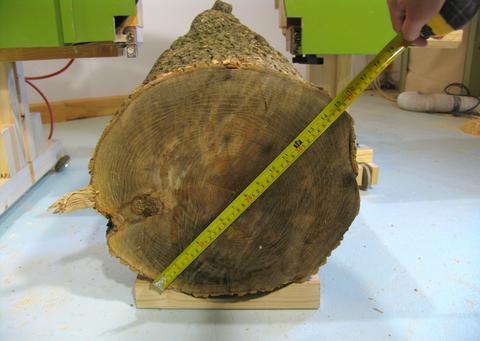 This chunk of log is 38 cm, or about 15" in diameter. I figured my sawmill
should be able to handle logs up to 40 cm or 16", so this was close to the limit.
This chunk of log is 38 cm, or about 15" in diameter. I figured my sawmill
should be able to handle logs up to 40 cm or 16", so this was close to the limit.
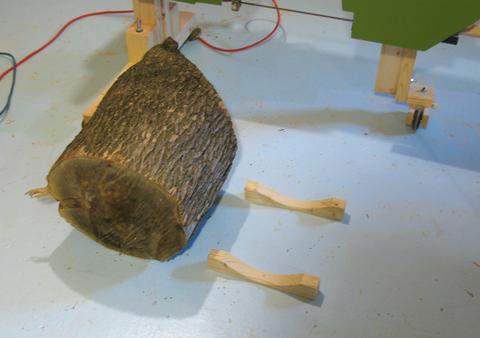 After I built my mini sawmill
I obtained a piece of a firewood log from a neighbour. I would really prefer
longer pieces, but the nice thing about this chunk was that it was
easier to carry into my basement.
After I built my mini sawmill
I obtained a piece of a firewood log from a neighbour. I would really prefer
longer pieces, but the nice thing about this chunk was that it was
easier to carry into my basement.
I made some "cradles" to place the log onto so that it would not roll to the side.
 This chunk of log is 38 cm, or about 15" in diameter. I figured my sawmill
should be able to handle logs up to 40 cm or 16", so this was close to the limit.
This chunk of log is 38 cm, or about 15" in diameter. I figured my sawmill
should be able to handle logs up to 40 cm or 16", so this was close to the limit.
My saw only opens up to 35 cm (14") wide, but that should be enough to cut slabs off the log. After slabs are cut off, the rest of the log will fit between the blade guides.
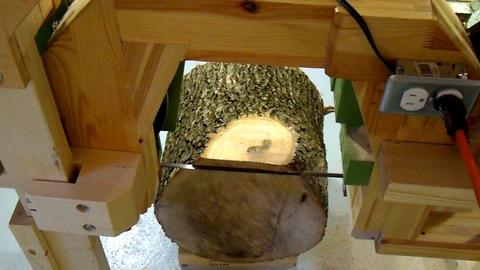 Starting to cut some slices off the log.
Starting to cut some slices off the log.
It would have made more sense to flatten this side of the log in one cut, but my goal was to test the saw. Removing thinner slices means more cuts and therefore more opportunities for testing.
I had to be careful with the first few cuts. The log was barely heavy enough to hold in place by gravity. A longer log would have more weight.
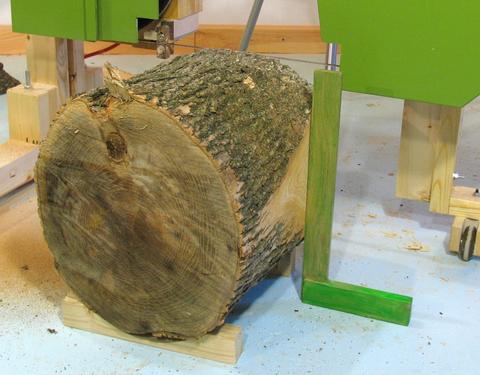 With one side flattened, I rotated the log by 90-degrees to take another slab off.
Here I'm using my green homemade square to check the angle.
With one side flattened, I rotated the log by 90-degrees to take another slab off.
Here I'm using my green homemade square to check the angle.
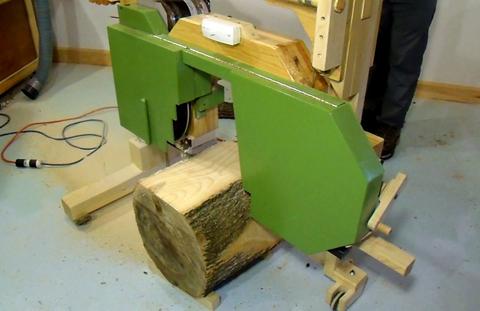 As I was starting to make wider cuts, I sometimes ran into shaking of the saw.
Putting both hands on the corners of the frames helped steady it, but I
still had to be careful.
As I was starting to make wider cuts, I sometimes ran into shaking of the saw.
Putting both hands on the corners of the frames helped steady it, but I
still had to be careful.
Sometimes the blade would bind a bit, yank the log, and then stall the saw. My advice is to practice reaching for the switch to shut it off quickly, so that you can shut it off as soon as it stalls. Only having a 1 HP motor on the saw is turned out to be a good "safety" feature. Better to have it stall than to do real damage!
My initial sawmilling experiments were while still using the flat belt drive, but on stalling, the motor would keep running and slipping against the belt. That belt sure smoked quickly when that happened.
I wasn't running into issues with blade drift. I put lots of tension on the blade. With a sharp blade, I really didn't need much feed pressure, so I didn't exceed the beam strength of the blade. I meant to switch to a 3/4" wide 3-TPI blade, but nobody had one in stock, so I kept using the 1/2" 3-TPI blade.
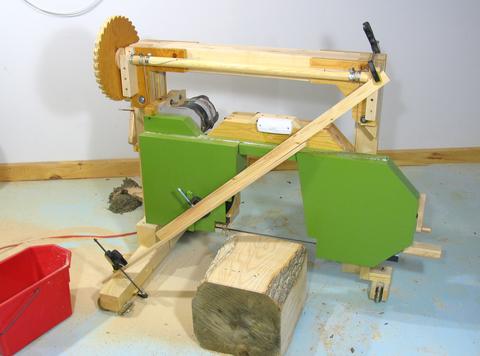 I found that when taking wide cuts, sometimes the saw would start to shake.
Having looked at lots of people's homemade sawmill videos on YouTube,
I knew that this sort of shaking is a common problem.
A stiffer frame would surely help, but
that would mean making it heavier and less portable. I experimented
with bracing it. This reduced the shaking to some degree but didn't
eliminate it.
I found that when taking wide cuts, sometimes the saw would start to shake.
Having looked at lots of people's homemade sawmill videos on YouTube,
I knew that this sort of shaking is a common problem.
A stiffer frame would surely help, but
that would mean making it heavier and less portable. I experimented
with bracing it. This reduced the shaking to some degree but didn't
eliminate it.
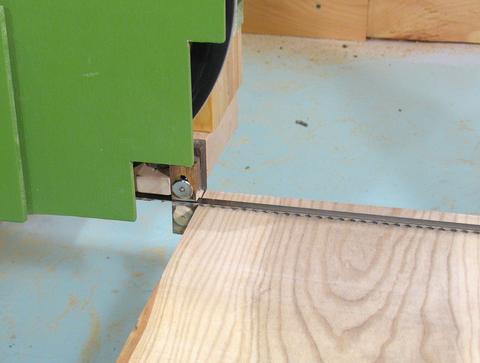 Running the bottom blade guide against the log
as it's cut was able to eliminate the shaking.
Running the bottom blade guide against the log
as it's cut was able to eliminate the shaking.
The shaking is all about relative motion between the log and the bandsaw. If the saw and log are in contact as shown, that eliminates that possibility.
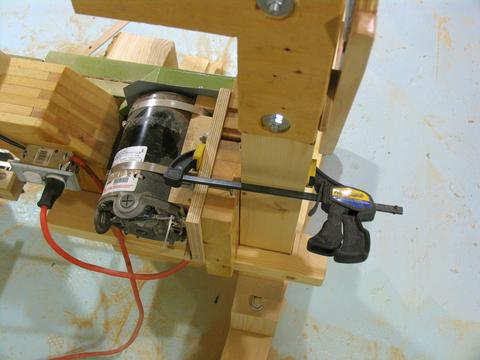 Having the bottom blade guide run against the edge of the log isn't always practical.
Having the bottom blade guide run against the edge of the log isn't always practical.
But then I had the idea of clamping the bandsaw frame to the sawmill frame together with a bar clamp. That pretty much solved the problem, and I didn't bother running the blade guides against the log after that.
The clamp doesn't need to be on very tight, just moderate pressure. In fact, I was still able to crank the head up and down with the clamp on.
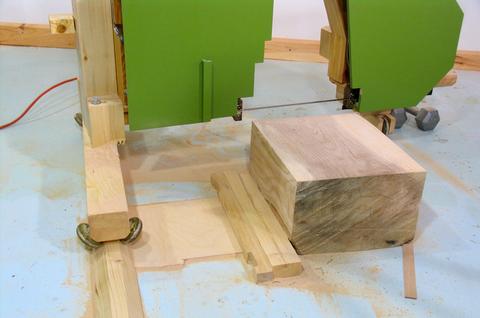 Although the sawmill worked well enough without a rail, the rail is very helpful
to keep things from drifting. Propping some pieces of wood between the
rail and the stock helped to keep everything well aligned from one cut to the next.
Although the sawmill worked well enough without a rail, the rail is very helpful
to keep things from drifting. Propping some pieces of wood between the
rail and the stock helped to keep everything well aligned from one cut to the next.
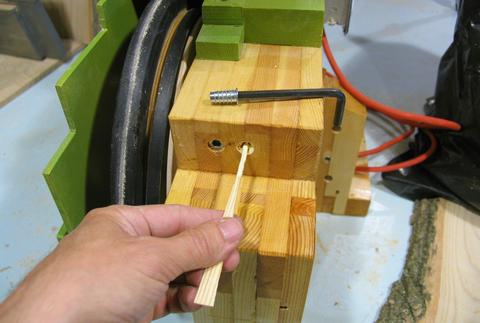 A few times, I had my stock jump loose and hit the bottom blade guide, knocking it loose.
With repeated tightening, eventually that threaded insert pulled out of the wood.
It was only screwed into the end grain, and I figured it would need gluing in eventually.
So I glued it, and then added a second threaded insert, also glued in, right
behind it.
A few times, I had my stock jump loose and hit the bottom blade guide, knocking it loose.
With repeated tightening, eventually that threaded insert pulled out of the wood.
It was only screwed into the end grain, and I figured it would need gluing in eventually.
So I glued it, and then added a second threaded insert, also glued in, right
behind it.
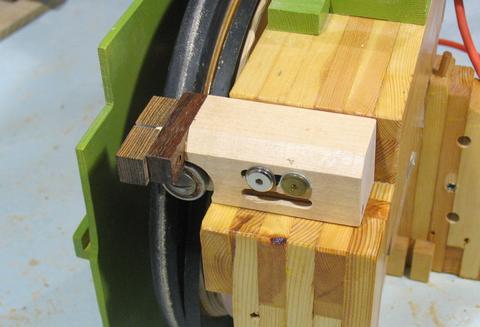 I figure with two screws holding the bottom blade guide, I should be ok.
I figure with two screws holding the bottom blade guide, I should be ok.
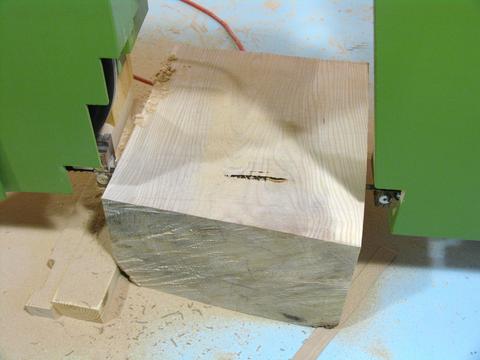 I was doing my tests with a 1/2" (12.5 mm) wide 3 TPI blade (8 mm tooth spacing).
This type of blade is meant for resawing at most 8" (20 cm) deep, and cutting 12.5" with
it was really pushing it. As long as the blade is really sharp, and the saw is pushed
very slowly, it makes for some very clean cuts.
I was doing my tests with a 1/2" (12.5 mm) wide 3 TPI blade (8 mm tooth spacing).
This type of blade is meant for resawing at most 8" (20 cm) deep, and cutting 12.5" with
it was really pushing it. As long as the blade is really sharp, and the saw is pushed
very slowly, it makes for some very clean cuts.
But once the blade gets just a little bit dull, it's almost like it refuses to go forward and just wanders sideways. My log was 32 x 38 cm (1.3 square feet), and after fourteen slices, it would go no further.
A wider blade, and with only two teeth per inch would have been better. As it is, each tooth needs to have a certain amount of "bite" to engage the wood. But making 32 cm (12.5") wide cuts, I can only apply so much force before the "beam strength" of the blade is exceeded. Once the beam strength is exceeded, the blade tries to escape sideways.
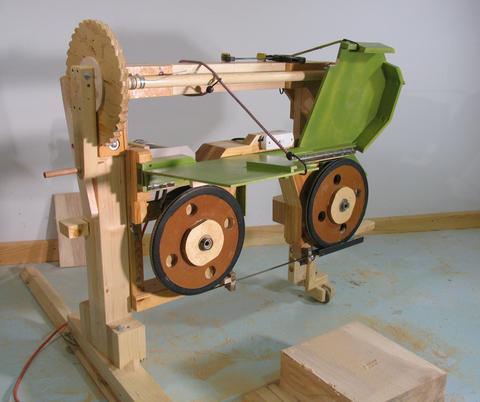 A quick
resharpen with the Dremel tool, and I was back in business. So I was certain
that it was the blade losing sharpness that made it wander.
A quick
resharpen with the Dremel tool, and I was back in business. So I was certain
that it was the blade losing sharpness that made it wander.
Removing the blade from the saw in sawmill configuration is a bit awkward. Bungee cords help to hold the covers open while taking the blade out.
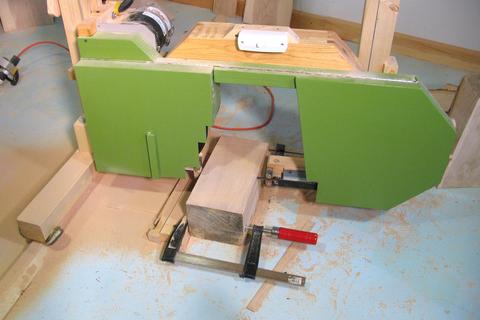 I was a bit disappointed at only being able to cut 14 slices of my log before
resharpening. That's was only 19 square feet, or 1.7 square meters of cut.
I was a bit disappointed at only being able to cut 14 slices of my log before
resharpening. That's was only 19 square feet, or 1.7 square meters of cut.
So the second time the blade was too dull to go further cutting full width, I experimented with cutting a block only half that width. At half the width, that same blade that was too dull for a 12" cut was more than sharp enough to keep on cutting. I was able to more than double the feed rate, so even my net rate of cut went up. So the blade can cut a lot more than 1.7 square meters, just not when pushing it outside of what it's meant to do.
The bar clamps in this photo aren't there to hold anything. I attached them to the piece of wood just to weigh it down. I was cutting fairly fast at this point.
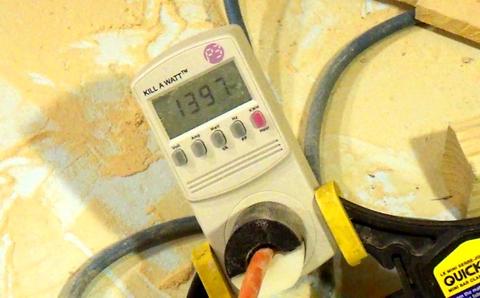 I hooked up a power meter to the motor to see how much power it was using.
The motor's label says 12 amperes. Even with a 1.0 power factor, that would be
about 1400 watts at 117 volts. But motors typically have power factors a bit less
than 1.0. The fact that I was pulling well over 1300 watts from time to
time suggests that I was using that 1 HP motor to its full capacity.
I hooked up a power meter to the motor to see how much power it was using.
The motor's label says 12 amperes. Even with a 1.0 power factor, that would be
about 1400 watts at 117 volts. But motors typically have power factors a bit less
than 1.0. The fact that I was pulling well over 1300 watts from time to
time suggests that I was using that 1 HP motor to its full capacity.
A bit more power would have been nice to have, though I wouldn't want to have too much. I prefer stalling the saw to causing damage.
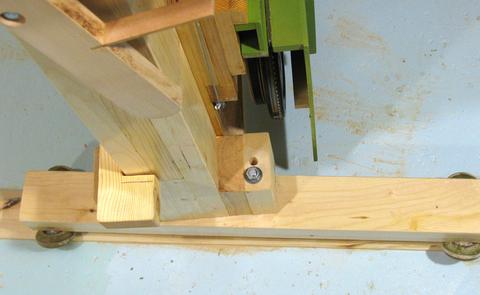 My experience with the table saw is that the saw has a much easier time cutting
when the teeth are cutting into the grain instead of out of the grain.
For example, doing a regular rip cut, the teeth cut into the grain, but cutting
tenons, the teeth move out of the grain. Cutting tenons is much harder.
My experience with the table saw is that the saw has a much easier time cutting
when the teeth are cutting into the grain instead of out of the grain.
For example, doing a regular rip cut, the teeth cut into the grain, but cutting
tenons, the teeth move out of the grain. Cutting tenons is much harder.
 Some bandsaws, such as the
Wood-Mizer twin vertical saw put the bandsaw at a skew so that the teeth
are cutting slightly into the wood.
Some bandsaws, such as the
Wood-Mizer twin vertical saw put the bandsaw at a skew so that the teeth
are cutting slightly into the wood.
So I figured this is something I should try on my sawmill. By putting multiple mounting holes on the frame, it can be mounted on the part that rides on the rail at an angle. The wheel on the other side of the saw can also be set at an angle.
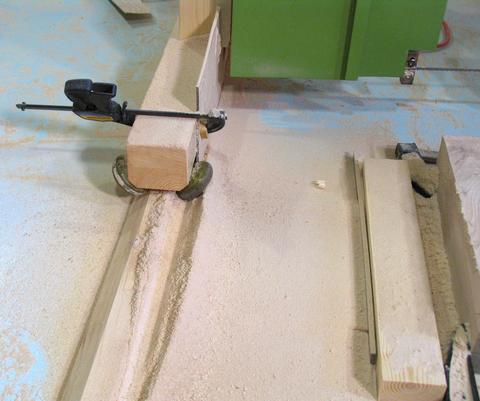 The benefit from skewing the cutter head is relatively small, so it's hard to
say how much of a difference it makes. But I'm quite certain that it doesn't hurt.
The benefit from skewing the cutter head is relatively small, so it's hard to
say how much of a difference it makes. But I'm quite certain that it doesn't hurt.
One problem I haven't yet solved is sawdust buildup. After only a few boards, the sawdust get high enough to interfere with the track. I experimented with clamping a piece of wood against the rail to deflect dust away from it, but that didn't make much difference.
What probably would help is to elevate the rail a bit, so that there is more room for sawdust buildup below before it gets to the wheels.
I'm quite sure this problem is solvable, just that I hadn't focused on that aspect yet.
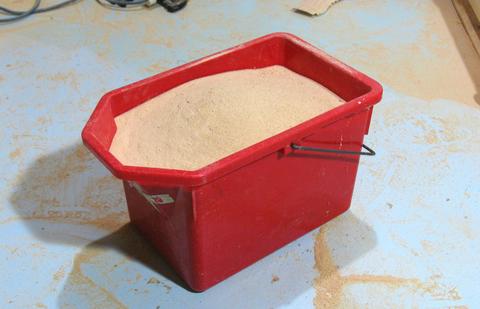 With all my experimenting, I made quite a lot of sawdust. Enough to fill this
bucket twice. Much of this is the result of cutting thin veneers. Not that I need veneer,
but I wanted to exercise the saw as much as possible.
With all my experimenting, I made quite a lot of sawdust. Enough to fill this
bucket twice. Much of this is the result of cutting thin veneers. Not that I need veneer,
but I wanted to exercise the saw as much as possible.
(I did find a use for that veneer later)
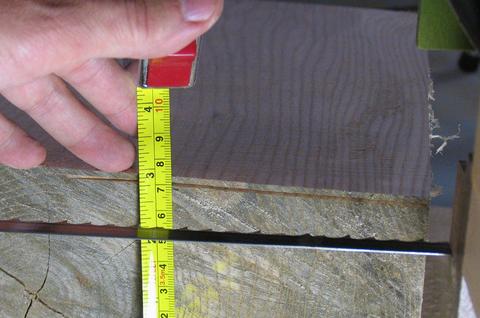
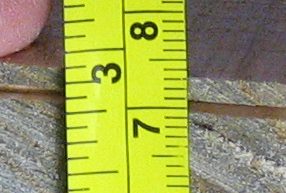 Because this "sawmill" is more of a bandsaw than a bandmill, it also has
a narrow kerf like a bandsaw. The kerf is about 1.2 to 1.3 mm wide. So this sawmill
would actually be a good saw for cutting up particularly valuable stock.
Because this "sawmill" is more of a bandsaw than a bandmill, it also has
a narrow kerf like a bandsaw. The kerf is about 1.2 to 1.3 mm wide. So this sawmill
would actually be a good saw for cutting up particularly valuable stock.
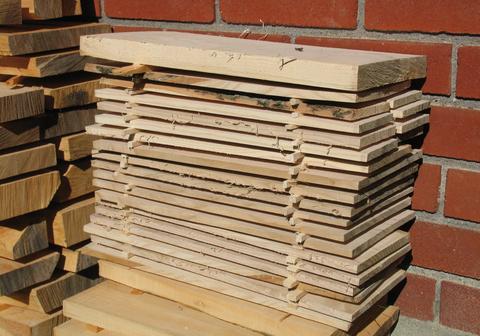 I only had a few log sections to test with for the time being, so I cut it into
lots of thin pieces to maximize the number of cuts.
I only had a few log sections to test with for the time being, so I cut it into
lots of thin pieces to maximize the number of cuts.
 Here's the veneers spread out. These are 2 mm thick. That makes them quite flexible,
and unfortunately prone to warping. I have no need for this veneer, but I figured, having
cut it, I might as well dry it. It would be a good starting point for making
plywood. It's certainly smooth enough to glue straight up.
I later used some of those pieces to make some
homemade plywood.
Here's the veneers spread out. These are 2 mm thick. That makes them quite flexible,
and unfortunately prone to warping. I have no need for this veneer, but I figured, having
cut it, I might as well dry it. It would be a good starting point for making
plywood. It's certainly smooth enough to glue straight up.
I later used some of those pieces to make some
homemade plywood.
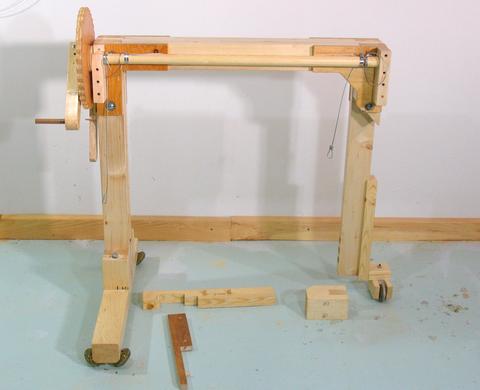 I don't need the sawmill all the time. That's why
the head of this "sawmill" is a bandsaw
that can be used for other things as well.
I don't need the sawmill all the time. That's why
the head of this "sawmill" is a bandsaw
that can be used for other things as well.
Here are all the extra parts that are needed to convert the bandsaw into a sawmill. Not shown are the 2x4's used as rails.
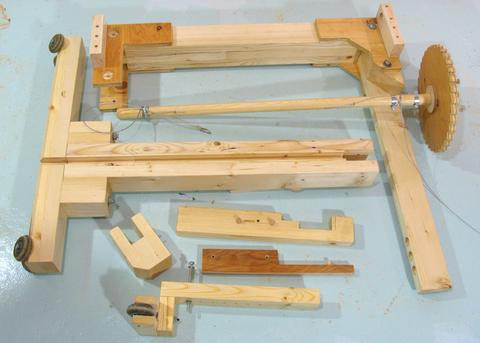 And here it is partially disassembled. The two large brackets shown can be
broken down further, but this is compact enough to get the whole thing into my
car.
And here it is partially disassembled. The two large brackets shown can be
broken down further, but this is compact enough to get the whole thing into my
car.
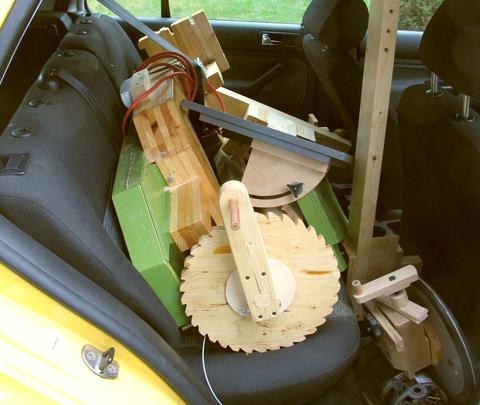 The bandsaw and sawmill frame in the back seat of my car. All loaded up
to show it off at the
Ottawa Woodworkers Association meeting.
The bandsaw and sawmill frame in the back seat of my car. All loaded up
to show it off at the
Ottawa Woodworkers Association meeting.
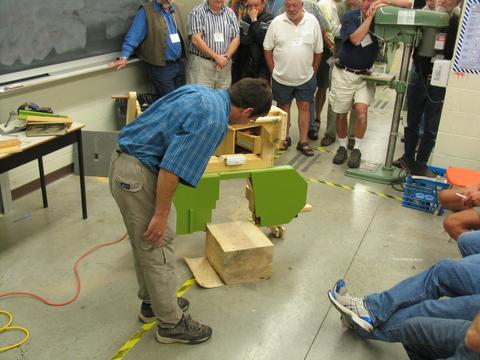 Here's starting to slice a 2 mm piece of veneer off a log. People were very
impressed by that. Vic Tesolin told me afterwards that he didn't think
this thing would work until he saw it cut up that log.
Here's starting to slice a 2 mm piece of veneer off a log. People were very
impressed by that. Vic Tesolin told me afterwards that he didn't think
this thing would work until he saw it cut up that log.
Next: Milling a log in my backyard